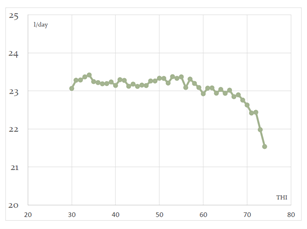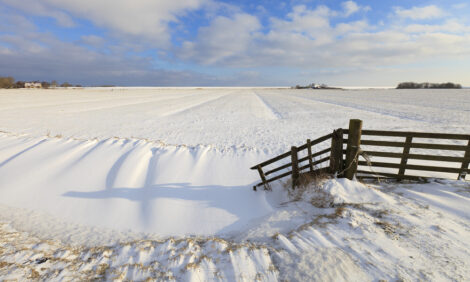



HealthyLife research grant awarded to heat stress dairy project
Dr. Tom Chamberlain, veterinarian and owner of Chalcombe Consultancy, is recipient of a HealthyLife research grant awarded by Trouw Nutrition, the animal health division of Nutreco. Dr. Chamberlain’s grant of €10,000 was awarded for his project, “Raising the awareness of heat stress problems with dairy farmers”.The HealthyLife Project aims to improve the sustainability of dairy farming by increasing the longevity and performance of dairy cows. Dr. Chamberlain’s award-winning research has two critical aims. First, it seeks to increase awareness that heat stress can affect cattle in temperate climate zones such as Europe and the coastal areas of Latin America and North America. A second aim is to establish Temperature Humidity Index (THI) data for grazing cows, as data currently represents only housed cattle.
Remarking on the grant, Dr. Chamberlain states, “A common way to quantify the risk of heat stress is the Temperature Humidity Index (THI), an index that combines environmental temperature and humidity, but has two limitations. First, threshold values are often based on studies working with cows that are acclimatized to high environmental temperatures and humidity and second, the THI values are only applicable to housed cattle.”
Dr. Chamberlain notes that threshold values in cattle in moderate climates, can be as low as 62 (See Figure 1, Hammemi, 2013). As THI threshold values are only applicable to housed cattle, he cites a clear call to gather data from grazed cattle in moderate climates.

Figure 1, Milk yield data from heifers in Belgium and Holland, (Hammemi, 2013) showing the threshold score for heat stress is 62, with moderate losses between 62 and 72, high losses between 73 and 79 and severe losses and death if the THI is above 79. These thresholds are lower than US data would suggest.
From a veterinarian’s perspective, Dr. Chamberlain says that in grazing situations it is preferrable to work with the Dairy Heat Load Index (DHLI, Lee, 2017), which is based upon recordings of humidity and temperature in a so called “black globe”. Placed where cattle are grazing, the DHLI provides an accurate measurement of the actual conditions that cows experience.
“With the help of Trouw Nutrition and Lallemand Animal Nutrition, we now have real-time data for THI and DHLI available from seven farms in the South-West of England,” he says. The results are available in real-time.
The research project also aims to provide farmers with a better tool to assess heat stress in their herds. Both THI and DHLI are environment-based as opposed to animal-based assessments. As such, they indicate to what extent animals are at risk, but do not measure the effect of heat stress in animals. The research project will develop a metric based on animal measurements.
Dr Chamberlain continues, “Previous research has developed animal-based metrics but these have been too invasive or expensive for commercial use. Our intention is to develop a metric that is simple to apply on commercial dairy farms.”
Cesar Bratz, Technical Manager at Trouw Nutrition adds, “At Trouw Nutrition, we are continuously looking for ways to help dairy farmers to increase their herds’ Lifetime Daily Yield. We are proud to support the project of Dr. Chamberlain, because we are convinced it will help create awareness that heat stress is a common problem in countries with moderate climates. Thanks to the endeavors of Dr. Chamberlain, farmers will not only be able to avoid loss of production, but they will also be able to avoid serious animal welfare issues as a result of heat stress.”
To look at the real time DHLI data, please visit: https://grazemore.co.uk/heat-stress
To find out more about the HealthyLife programme for sustainable dairy farming, please visit: https://healthylife.trouwnutrition.com


